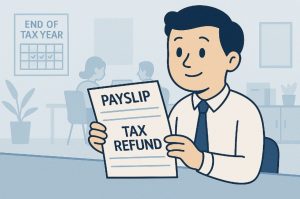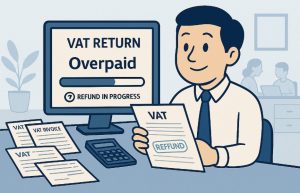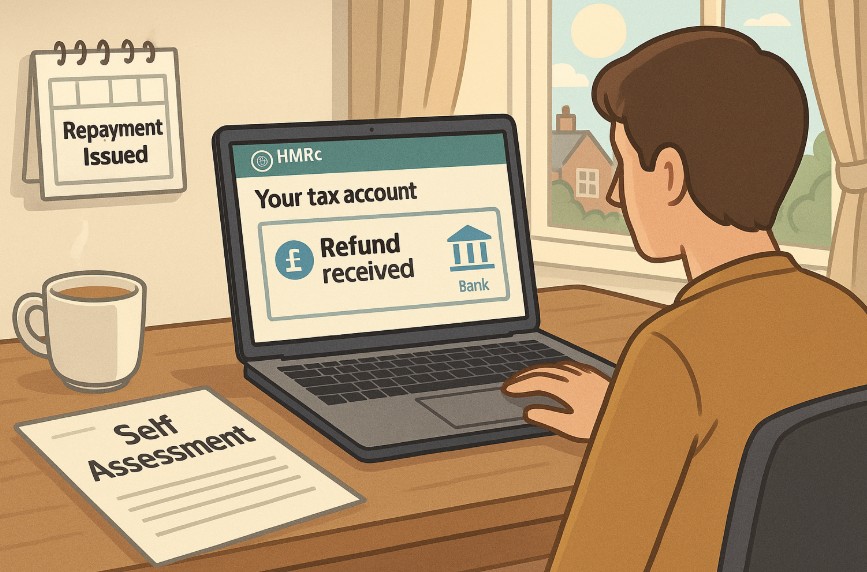Table of Contents
ToggleTax refunds are a welcome relief to individuals and businesses who have overpaid during the financial year. Whether it’s due to an incorrect tax code, self-employment overpayments, or VAT adjustments, the idea of getting money back from HMRC is appealing. However, once your online account reads “repayment issued”, the question becomes: how long does it actually take to receive the funds?
In this comprehensive guide, we explore every part of the HMRC repayment process from initial submission to the final transfer so you know what to expect and how to avoid common pitfalls that cause delays.
What Is HMRC’s Tax Repayment Process?

A tax repayment is essentially a refund of money you’ve overpaid to HMRC. This can happen for numerous reasons, such as:
- Your employer used the wrong tax code
- You stopped working part-way through the year
- Your estimated payments in Self Assessment were too high
- You’re claiming a tax relief or expense deduction
- Your business overpaid VAT or Corporation Tax
When you submit your tax return (via PAYE or Self Assessment), HMRC will check whether you’re entitled to a refund. If so, and no debts or liabilities are pending, they initiate a repayment process. This process includes credit verification, fraud screening, and selection of the repayment method (bank transfer, cheque, or card refund).
For most standard PAYE overpayments, the process is automatic. But for more complex claims such as VAT returns or Corporation Tax refunds the process may involve manual reviews or document requests.
How Does the HMRC Tax Repayment System Work?
HMRC’s system uses both automation and human oversight. Here’s a simplified flow of how a repayment request is handled:
- Submission: A return is filed, indicating overpaid tax.
- Credit Analysis: HMRC checks the account for available credit and pending liabilities.
- Verification: Recent payments or return inconsistencies are flagged for review.
- Repayment Drafted: If everything checks out, a draft repayment is created.
- Authorisation: Depending on the risk profile, the repayment is either automatically authorised or manually reviewed.
- Transmission: The authorised repayment is transmitted to the payment system (BACS, card system, or cheque).
- Payment: Funds are received by the taxpayer.
What If There Are Multiple Returns?
If several tax returns (for different years) are submitted on the same day under the same Unique Taxpayer Reference (UTR), HMRC will first process the earliest tax year. Repayment decisions are based on the net credit balance after accounting for all known liabilities.
What Does It Mean When HMRC Says “Repayment Issued”?

This status is key. When your HMRC account says “repayment issued”, it means the repayment has passed authorisation and has been released to the payment network.
However, this status is often misunderstood. It doesn’t mean the money is already in your account. Instead, it’s in the transmission stage, which includes final processing through the payment provider, most commonly BACS.
Depending on the method of payment, the time it takes for funds to land in your account can vary. Understanding the method involved helps set realistic expectations.
How Long Does It Take to Get a Tax Refund After HMRC Issues It?
Most tax repayments arrive within 5 working days of being issued. However, the actual timeframe varies by method and individual circumstances.
HMRC Repayment Timeframes by Method
| Repayment Type | Expected Time | Notes |
| BACS Bank Transfer | 3–5 working days | Standard method for Self-Assessment refunds |
| Credit/Debit Card Refund | Up to 5 working days | Used for PAYE refunds through the GOV.UK portal |
| Cheque (Payable Order) | 2–5 weeks | Slower due to manual processing and postage |
| P800 Online Claim (Bank) | Within 5 working days | Fast if claimed online |
| P800 Cheque (Default) | 2–8 weeks | Triggered if you don’t claim online within 45 days |
Common Scenarios
- Self Assessment Repayment filed early in the year is often issued within 3–7 working days.
- PAYE Refund via P800 may take longer if you don’t claim online promptly.
- Cheque payments face delays due to postal backlogs or incorrect address information.
What Is “Bank Repayment Pending”?

“Bank repayment pending” is a status that often precedes “repayment issued.” It means HMRC is in the process of transferring funds but has not completed the transaction.
This stage can last anywhere from a couple of days to a week. During this time, HMRC may be verifying details, ensuring no suspicious activity is involved, or waiting for recent payments to clear.
Why Does It Stay Pending?
- Recent changes to bank account info
- A large or unusual repayment amount
- Ongoing fraud prevention checks
- A manual review flag triggered by HMRC’s automated risk tools
If this status remains for more than 10 working days, it’s advisable to contact HMRC directly.
What Causes Delays in HMRC Repayments?
While most repayments are processed promptly, delays are not uncommon. Understanding the reasons behind them can help you take proactive steps.
Common Causes of Delay
| Cause | Description |
| Fraud Checks | Triggers include large refunds, new bank details, or filing patterns |
| Manual Review | Applied to flagged repayments needing clerical intervention |
| Banking Issues | Incorrect sort code or account number causes payment rejection |
| Recent Tax Payments | HMRC holds repayments for up to 14 days to prevent fraud |
| Peak Filing Times | January and April see high volumes, slowing processing |
| Voluntary Returns | Returns submitted outside HMRC’s filing request may take longer to process |
How to Speed Up Your HMRC Repayment?

While not all delays are avoidable, you can reduce risks by doing the following:
- Submit returns early: Avoid January’s backlog by filing in November or December.
- Keep your HMRC account updated: Ensure your name, address, and bank details are correct.
- Avoid changing bank details: close to the repayment season.
- Use the online Government Gateway: Digital submissions are faster and more transparent.
- Track your status regularly: Watch for changes like “repayment issued” or “pending.”
If your refund is delayed beyond expected timeframes, contact HMRC directly using your reference number to inquire about the status.
HMRC Fraud Prevention: What You Need to Know?
Fraud prevention is a critical part of the tax repayment process. While it protects the system, it also results in delayed repayments for some legitimate taxpayers.
What Triggers Fraud Checks?
- Updated bank details
- Sudden large repayment requests
- Irregular submission patterns
- Newly registered taxpayers
What Happens During a Fraud Check?
You may be contacted to verify identity, confirm bank details, or provide documentation proving entitlement. The process can take 1 to 6 weeks, depending on the complexity and how quickly you respond to requests.
Different Types of HMRC Repayments
Not all HMRC repayments follow the same process. Depending on the nature of the tax return or overpayment, the method and speed of your refund can vary significantly.
Whether you’re self-employed, a company director, an employee under PAYE, or running a business, understanding the different types of HMRC repayments is essential to manage expectations and ensure a smooth refund process.
Here’s an in-depth look at the most common types of HMRC repayments and what to expect with each.
1. Self Assessment Tax Refunds

Self Assessment (SA) is a system used by HMRC to collect income tax from self-employed individuals, company directors, or those with untaxed income.
If you overpay during the tax year, either by making excessive payments on account or due to reliefs and allowances, you can claim a refund when filing your SA tax return.
How It Works:
- You file your tax return online via the Government Gateway or send it by post.
- If HMRC calculates that you’ve overpaid, you can request repayment directly into your bank account.
- Repayments are usually processed within 5–10 working days if submitted online and there are no issues.
Common Challenges:
- Voluntary Returns (filed without a request from HMRC) may face manual review and are not always prioritised.
- Incorrect information or mismatched figures in the return may trigger a fraud check or manual hold.
Example:
A freelancer overestimates their profits and makes large payments on account. At the end of the year, their actual earnings are lower, and their return shows a £1,200 overpayment. After filing online, they receive the repayment in their account within 6 days.
2. PAYE Tax Refunds

Employees under the Pay As You Earn (PAYE) system may overpay income tax if:
- They have multiple jobs
- They leave a job mid-tax year
- Their tax code is incorrect
HMRC typically reconciles PAYE records at the end of the tax year and issues a P800 tax calculation if you’ve overpaid.
How It Works:
- If you’re owed money, HMRC sends a P800 and invites you to claim online.
- If you don’t claim within 45 days, HMRC automatically sends a cheque to your registered address.
Timelines:
- Online claim: refund within 5 working days
- Cheque: 14–60 days, depending on response and system backlog
Issues That May Arise:
- Delays due to incorrect addresses or expired bank details
- If you’ve changed jobs multiple times, reconciliation errors may delay repayment
Example:
An employee works two part-time jobs but is incorrectly taxed under an emergency code. At the year-end, HMRC issues a P800 and the taxpayer claims online. The refund is credited to their bank within 3 days.
3. VAT Refunds (Businesses)

Value Added Tax (VAT) refunds apply to VAT-registered businesses that have paid more VAT on purchases than they’ve collected from sales. This is common in capital-intensive industries like manufacturing and construction.
Process:
- Businesses file quarterly VAT returns using HMRC’s Making Tax Digital system.
- If the return shows a net reclaim position, HMRC processes the refund, typically within 10 working days of submission.
Key Points:
- VAT returns filed with errors or inconsistencies are flagged for manual review.
- Large refund claims are more likely to be audited to prevent fraud.
Example:
A construction firm invests in new equipment and inputs more VAT than it invoices to clients. They submit a VAT return with a £30,000 reclaim. HMRC reviews the return, requests supporting invoices, and issues repayment after 3 weeks.
4. Corporation Tax Repayments

Corporation Tax is paid by limited companies on their taxable profits. A repayment may arise if:
- The company overpays based on estimated profits
- There is a loss carry-back
- An R&D (Research and Development) tax credit is claimed
R&D Tax Credit Repayments:
These are especially common for startups and innovative businesses. Companies undertaking qualifying R&D activities can claim a cash credit from HMRC, even if they’re not currently profitable.
Timeline:
- Standard CT600 Corporation Tax refund: 28–45 days
- R&D Tax Credit repayments: 4 to 8 weeks, possibly longer if under audit
Risks of Delay:
- Incomplete documentation for R&D claims
- High refund values trigger in-depth scrutiny
- Claiming reliefs without proper guidance can lead to rejection
Example:
A tech startup claims £15,000 in R&D relief. Due to the size of the claim, HMRC requests a detailed report and financial evidence. After compliance checks, the refund is issued 6 weeks later.
5. CIS (Construction Industry Scheme) Refunds

Subcontractors working under the CIS scheme often have tax deducted at source. At the end of the tax year, many find they’ve overpaid and are due a refund through Self Assessment.
Process:
- CIS deductions are included in your Self Assessment return.
- HMRC verifies the amounts withheld from contractors’ monthly returns.
- Once verified, the repayment is processed like any other Self Assessment refund.
Issues:
- Discrepancies between what the contractor reported and your submission can delay processing.
- Repayment requests involving paper documentation are significantly slower.
6. Student Loan Overpayment Refunds

If you continue repaying your student loan after it’s already been cleared (often due to outdated employer data), HMRC can issue a refund through the Student Loans Company (SLC).
Timeline:
- Typically, within 4–6 weeks, depending on verification and the SLC’s communication with HMRC
Tip:
- Monitor your loan balance and contact the SLC directly as soon as you notice overpayments.
7. National Insurance Overpayment Refunds

Occasionally, individuals may overpay National Insurance contributions, especially if:
- They switch between employed and self-employed status
- Have multiple jobs with overlapping NIC thresholds
These refunds are not automated and usually require a formal request to HMRC.
Process:
- Submit a request with evidence of overpayment
- HMRC assesses records across different employers
- Refund issued by bank transfer or cheque
Timeline:
- Typically 6–12 weeks, depending on complexity
Types of HMRC Repayments
| Type | Average Processing Time | Risk of Delay | Common Delay Reasons |
| Self Assessment | 5–10 working days | Medium | Manual review, incorrect data |
| PAYE (P800) | 5–60 days | Low–Medium | Missed online claim, outdated address |
| VAT Refund | 10–30 days | High | Large claim, audit triggered |
| Corporation Tax / R&D | 4–8 weeks | Medium–High | Missing evidence, claim audit |
| CIS Refunds | 7–14 days | Medium | Mismatch with contractor data |
| Student Loan Overpayment | 4–6 weeks | Low | Delayed data from SLC |
| National Insurance Refund | 6–12 weeks | Medium | Multiple jobs, manual checks across records |
Conclusion: When Will You Actually Receive Your HMRC Refund?
So, how long after repayment is issued by HMRC will you get your money? In most cases, expect funds within 3–5 working days, but be prepared for longer delays depending on your payment method, return type, and whether fraud checks are involved.
Being proactive, filing early, checking your details, and monitoring your HMRC account will significantly improve your chances of a smooth refund experience.
FAQs About HMRC Tax Repayment Timing
How do I confirm my repayment has been issued?
Log in to your HMRC account. If the status says “repayment issued,” it has passed internal checks and has been sent for payment.
How long does a BACS refund take from HMRC?
Typically, 3 to 5 working days after the repayment is authorised and marked as issued.
Why is my repayment still marked “pending”?
It could be due to additional checks, recent payments, or bank verification delays.
What should I do if I’ve waited over 10 working days?
Contact HMRC. Have your reference number and submission date ready for quicker support.
Is it faster to claim a P800 refund online?
Yes, claiming online results in quicker bank payments compared to waiting for a cheque.
Can HMRC repay less than £10?
Only if you specifically request it. Otherwise, it remains as a credit on your account.
What if HMRC sent my refund to the wrong bank?
It will bounce back and be flagged as “rejected.” HMRC will contact you to update details.




